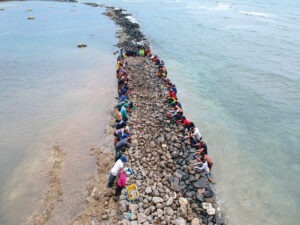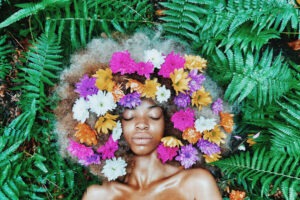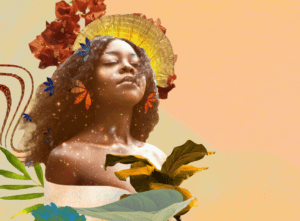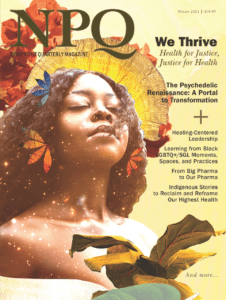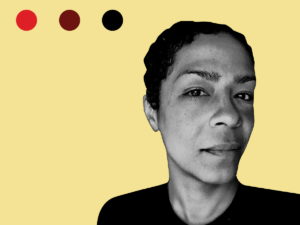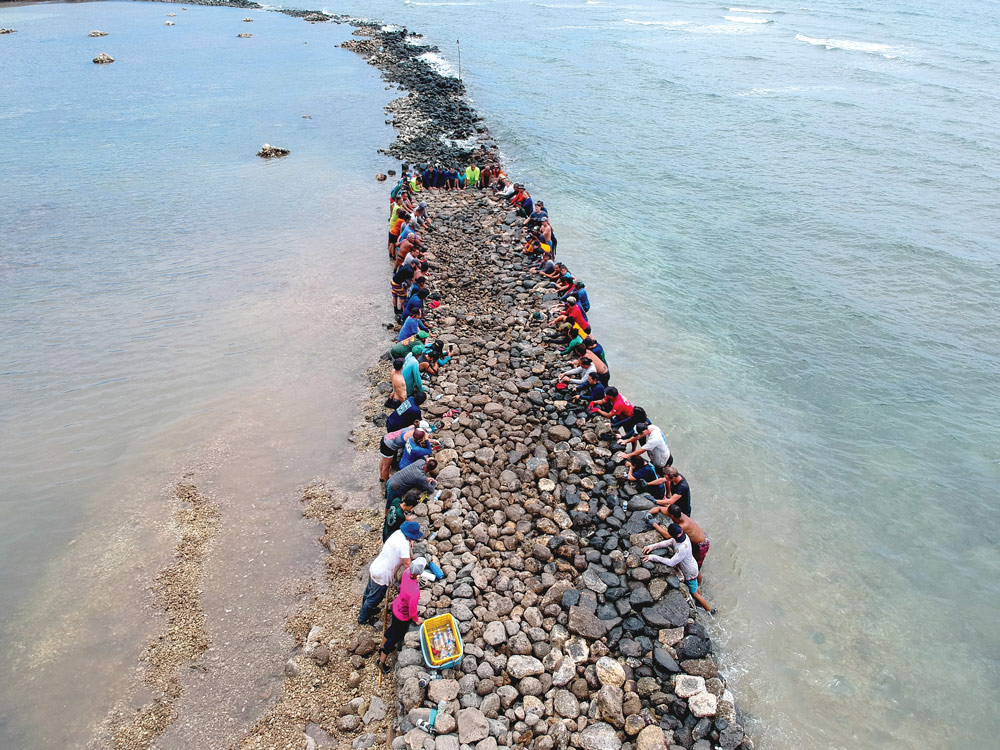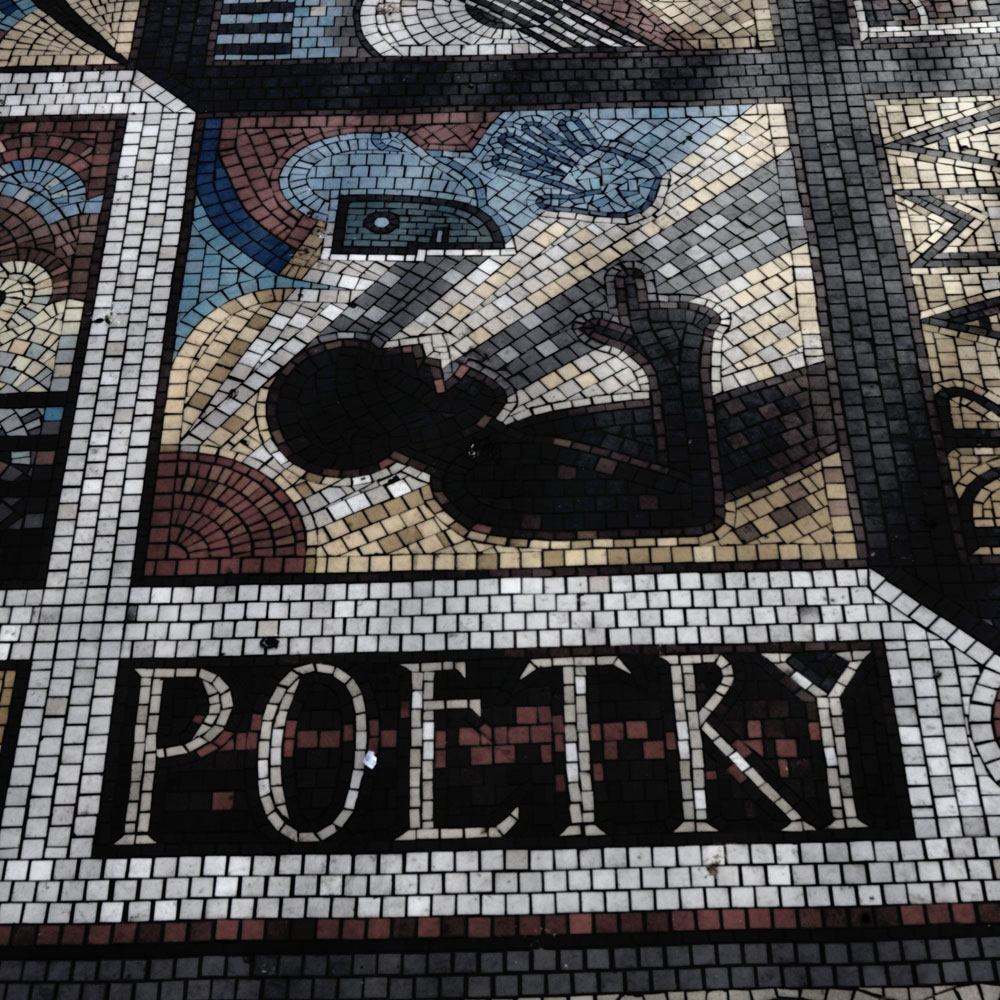
Jeanne Bell: Tell me a little bit about this term, and this notion of a “Cultural New Deal.” It references obviously the original New Deal, but how are you thinking about it, you and your fellow artists and activists?
Tess Taylor: Well, I think there’s a couple of communities that are using the word “Cultural New Deal.” And there’s a way in which I began using that phrase, because Green New Deal is a lovely vision, and everybody gets that it’s environmental investment that’s supposed to stimulate the economy, and generate jobs, and help provide the tools to get to the cleaner, greener economy that we want. But I think it’s really important for us to remember that the original New Deal also had provisions for artists at every single rung of the ladder. Artists were out designing monuments and national parks. The Federal Writers Project had writers all over America gathering oral histories that are really still of great import to us, making new archives, and helping to engage with communities.
And then, of course, there’s people like Dorothea Lange, who was part of the Farm Security Administration. The Farm Security Administration! What of, you know, rural revitalization? That’s something where we forget that these pairings were sort of unexpected, and not exactly intuitive, and yet very rich. They yield us very rich legacy. So, one of the things that’s been on my mind is just asking, “What can those models offer us now? What could seeding artists into unexpected places—in American infrastructure, American agriculture, as Secretary of the Interior? What could we do with artists? And what could they help us build that would allow us to process, and repair, and comment on, and collect, and admire America?”
Jeanne: Are you suggesting that there might be potential for partnership, of a major economic deal or economic policy embracing the arts explicitly, as opposed to hoping it happens at the local level, for instance?
Tess: It’s absolutely clear that artists won’t get a seat at the table unless we ask to be there, and unless we say why we can bring something very important to the table. So one of the things that I’m really interested in is the role of the arts in building healthy communities in health, providing great health outcomes, and actually dismantling some of the toxic effects of racism. One of the groups that’s working very hard to give artists a seat at the table is a group called Be An Arts Hero that’s sponsoring something called the DAWN Act, and that’s “Defend Arts Workers Now.” And what’s really important about that is that it really casts the arts as an economic driver, and that arts businesses are part of every small community, every congressional district, and that by investing in them, we’re revitalizing American communities.
They’re really trying to remind us that the arts are pollinators for all kinds of other businesses that happen. And the thing that they’re also urging is that there be a Secretary of Arts and Culture. You know, we’re one of the only developed countries that doesn’t have somebody to make strategic decisions around channeling and investing money in a piece that’s such a huge part of our economic world. So that’s kind of talked about, as a “Dr. Fauci of the arts.”
Jeanne: You mentioned Dorothea Lange. And I know that you spent a lot of time exploring her. Do you want to share something from that work and just give us a sense of what that experience was like for you?
Tess: Well, yeah, in some ways, this is another genesis of my interest in this kind of topic. I live in a town that Dorothea Lange photographed in the 1940s. She photographed it for two reasons. One was it was sort of the end of the Great Migrations that she’d been covering in terms of people living roadside, working shift jobs. There was a boomtown happening right near where I live, and there was a desegregated shipyard, and there was a war effort. And so there was something of the middle class dream, and also a kind of forward-looking, desegregated America that she photographed really lovingly in the year 1942.
At the same time, people in the same town and in the same weeks were being pulled out of their homes and sent to internment camps because they were Japanese. So she was seeing in this little suburb of Northern California, El Cerrito, some of the paradox of America. And so, learning that history, and knowing about her, and, you know, living in Berkeley, where she also lived, circling the Bay Area, I got this question in my mind: “Well, what would Dorothea Lange make of the landscape now?”
And those of you who thread through California will know that we are in a real crisis of shelterlessness. There’s an epidemic of people living on the streets. And arguably, since you’re policy people, part of that is having some of the New Deal provisions for housing erased. So, what would Dorothea Lange want to see today?
That was the question in my mind. And what I did is I went to the Oakland Museum and read…saw her contact sheets, but I also read the notes that she kept from her journeys of the 1930s and ’40s. And I revisited the places that she’d been. And I was just struck by what a beautiful lens and record she offered for understanding and decoding the paradox of America and the paradox of California. And I really fell in love with this gift that America leaves to us, which is these free archives of her work in the Library of Congress, that Dorothea Lange helps decipher America for Americans, that we really can look back at that work and make sense of it.
And then began to think of the magnitude of these WPA gifts in terms of the oral histories of enslaved people, in terms of the oral histories that Zora Neale Hurston picked up on her way through Florida, and just realizing that this was this moment where the American government had the foresight to create this trove of riches that we can inherit. And if you stand in line at a post office, and you feast your eyes on a mural, it might be by somebody like Marguerite Zorach. And there’s all of these beautiful things. My high school, Berkeley High, has a community theater that was a WPA project.
So, partly I became fascinated with Dorothea Lange. And partly I just began to see through her the magnitude of what this era has left us.
Jeanne: I would love it if you read a passage or a poem.
Tess: I’m going to read from the end of the book. I wanted to show you this book is through the Museum of Modern Art. It was part of the Dorothea Lange Words and Pictures exhibition, which was up at MoMA last year—and interestingly, right as we were heading into the pandemic, and people were falling out of work at that level, and it pairs Dorothea Lange’s notebooks with my own observations, and also kind of less iconic Lange photos. So, I’ll just read from three pages at the end of the book.
This poem is composed of Dorothea Lange’s notes to herself in her notebook. She didn’t make that many notes to herself, but over 10 years, she made them, and I smashed them together in this order.
Note to Self
Possible title: To Hold This Soil.
Note to Self
General theme of book
“People left stranded by the outwash of industry in America.”
Note to Self
US 99, the splendor and the rest of it.
Note: young trees
Note: poor man’s canyon, a subject on the move.
Note to Self
Really do the work
Follow the whole travel
Destination Unknown.
-
- The Method.
- this still blank.
a book on the conditions of US
Dear Dorothea,
Sign up for our free newsletters
Subscribe to NPQ's newsletters to have our top stories delivered directly to your inbox.
By signing up, you agree to our privacy policy and terms of use, and to receive messages from NPQ and our partners.
I wrote all year at rest stops, on roadsides, at gas stations
in sweltering dust beside the GLIDE Church
near your old studio, and beneath pesticide-sprayed walnut leaves
near the Sunsweet dryers, and so many tents
in a bungalow where lawyers defend caged children
also one summer morning when sage and sticky monkey
met the soft fog off the sea, at labor camps reclaimed by crabgrass and amid evicted stoves
near rice paddies of Knights Landing near Esparto where sunflowers sank into their black hulls
at Codornices Creek behind the brown shingle you came home to
I saw one yellow finch
thought again about the body, how to house the fragile human
in labor, dreams, and rest.
And I’ll just close with this photo from Nipomo, California, where she took that famous photo, “Migrant Mother.” So here I am, there, listening to someone looking for the place where she took the photo, and I’ve asked for directions. And here’s the poem, poem-speech, that I got back.
Nipomo, Sunday, 2019.
You’re looking for the woman who shot the photo.
Yes, we know about her. My parents talk about her.
People come still, looking for her.
Like you, they want to know about her.
We see ’em passing through this town,
trying to find out where she made the photo.
Guess the spot could be lots of places. Don’t know where exactly.
Yes: we have a pride in her. We’re proud of her.
And: I think you can find it. You can drive there.
Maybe Google?
Might be over the bridge, beyond the bluff, across the valley.
Find the old people. They would know.
Find them: Ask them to remember.
Jeanne: Thank you so much. There was a lot conveyed in those. I love those notes to “do the work.” I love that notion.
Can I ask you finally about your own mindset around, if you call it this, activism? Or, you know, using your voice to articulate the needs of artists and the potential role for arts and civic life? Why are you doing that? What has been your experience of that kind of leadership, if you call it that?
Tess: Well, this moment has been extraordinary, like nothing we’ve ever seen. And watching my own year’s income get washed away, and being fortunate enough that I live in a house where, and in a state where, and in a place where we could compensate, although there was a lot of stress and struggle this year.
Thinking about the work of all of the people who are wanting to teach, or wanting to make beautiful things, wanting to play in a symphony, the skill that goes into becoming a singer for the Met. And just thinking about the fact that artists have really become aware of themselves as temporary workers this year, and artists have become aware of their precarity this year, and yet we have so much that we can offer. And we do so much to help communities thrive, and to help people thrive, and to help economies thrive.
You know, I’ve been an activist in moments of my life, more or less, and this just felt like a natural thing to pick up and to begin doing. For me, I don’t really see a contradiction between that and the work of art. They’re not necessarily the same, at the same time. Sometimes, if people ask me what I’m writing right now, I’m actually writing rather quiet and small poems that have this sort of discrete space and are almost meant to offer people or myself time to breathe and reroute. So, I don’t necessarily think that art and activism are always the same. But I do feel like the gesture of wanting to build this ecosystem outward and wanting to work to defend it, not just for myself, but for all of the good that we can do has just been really energizing, and it feels right. So that’s been a joy.
Jeanne: Tess Taylor, thank you for spending time with Nonprofit Quarterly.
Tess: Thank you so much for having me. And thank you, nonprofits, for thinking about how you could weave an artist into your work.



